Quicklinks
Quicklinks
Hamburg is one of the ports with the best and most connected IT networks in the world. Digitalisation enables the efficient handling of 8.7 million containers and more than 8,000 ship calls per year. Which digital locks must an export container pass through before it is shipped?
Germany is the top exporter of goods and products in Europe; globally, only China and the USA export more. In this country, nearly every fourth job depends on exports.

The Port of Hamburg is the most important hub for the export of goods from Germany and other European countries. In 2021, a total of approximately 129 million tonnes of goods from around the world were handled via this central hub, close to 60 million tonnes of which were exported. Containers make transhipment and transport particularly easy and secure. These days, nearly everything can be transported in the colourful steel boxes that dominate port handling.
With such an enormous throughput volume, digital networking plays a crucial role for all the companies and authorities that are involved in the export processes. More than 8,000 ships call at the Port of Hamburg annually, and more than 200 cargo trains arrive or depart daily. Many players must coordinate their efforts. Transport processes can only run smoothly when information is transparent and available to everyone early on.
For this reason, there are multiple digital platforms and applications in Hamburg that connect everyone involved in the export process – from the collection of the container from the forwarder in southern Germany, for example, to the ship’s departure in Hamburg. Follow the process on the map below by scrolling down.
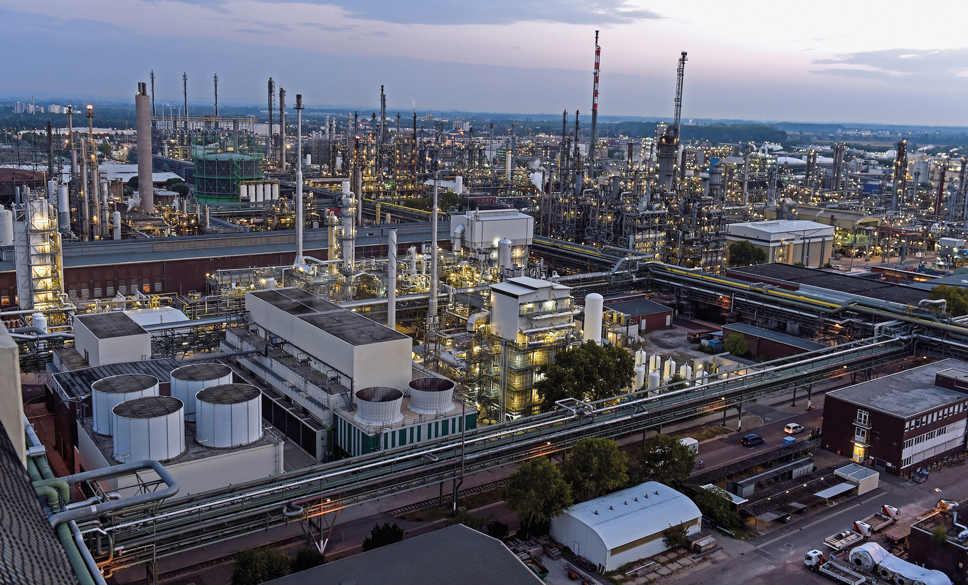
Industrial density is particularly high in southern Germany. Many export containers are sent on their way from there every day. We accompany two of them en route to the HHLA Container Terminal Altenwerder in the Port of Hamburg. They are loaded with high-grade automotive paint from the Rhein-Neckar region. From Hamburg they are transhipped onto the MADRID EXPRESS, a large container ship belonging to the Hapag-Lloyd shipping company, to begin their journey overseas.
Yet before the containers have left the port on the ship, up to 14 different players are involved in the transport process. Apart from the forwarder, the freight forwarder, the transport companies and the shipping company, many other entities must be involved. It is difficult to maintain an overview. In earlier times, many forms used to be filled out, printed, sent, faxed and filed. Today people depend on digital platforms such as the Port of Hamburg’s Port Community System, operated by DAKOSY
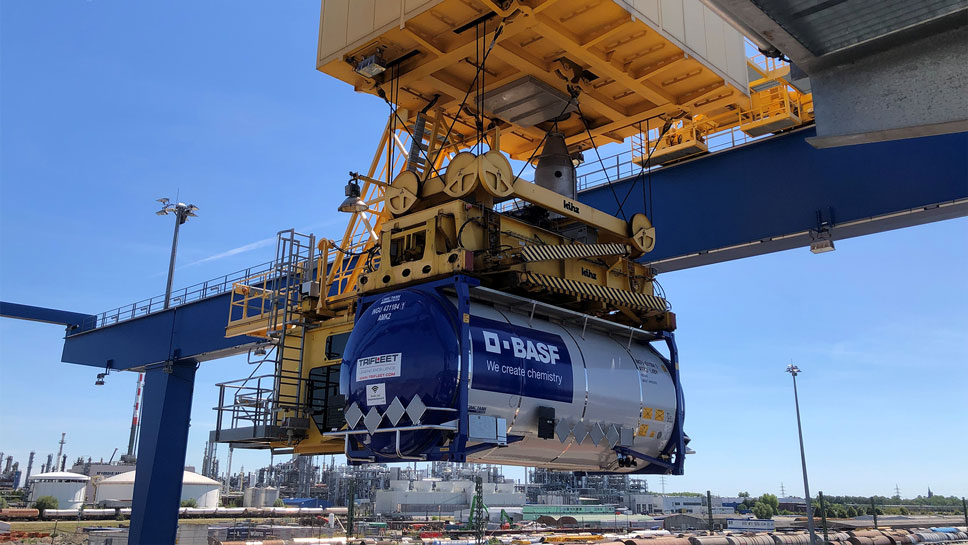
“Intermodal transport”, which connects carriers, is an efficient and environmentally friendly method of transporting goods over long distances from point A to point B. It pools resources by combining trucks, trains and inland waterway ships. For example, one electric 740-metre cargo train can replace up to 52 diesel trucks.
The two containers full of automotive paint will also arrive at the Port of Hamburg by rail as a result of intermodal transport. First, the truck picks them up from the production site and brings them to a transhipment station. The plan is for the train to take over the main leg from there. However, things don’t always run smoothly along the transport chain.
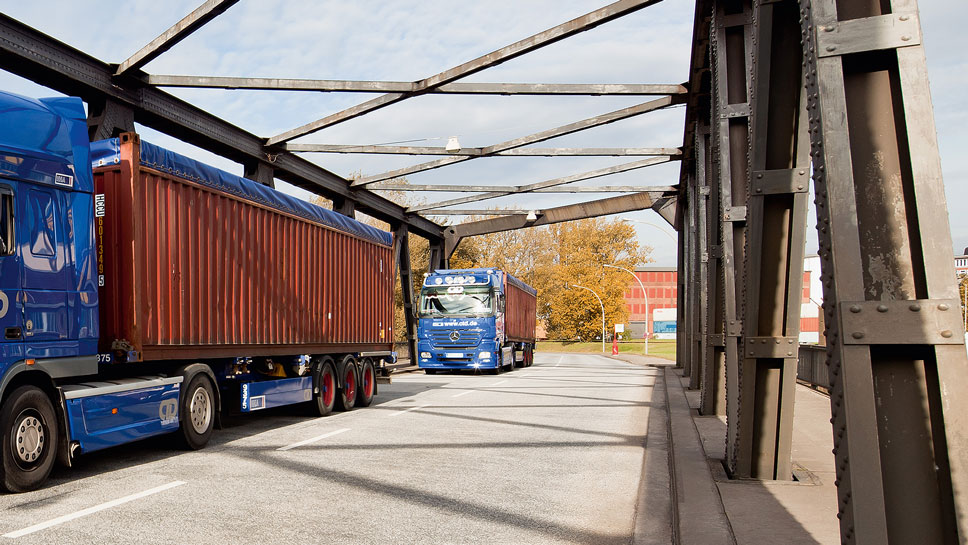
Due to traffic congestion on the motorway, one of the two containers fails to get to the railway loading site on time. Technical difficulties, traffic congestion and strikes are just a few of the possible reasons for delays in the supply chain. This makes good networking among all those involved even more important.
The new EMP 4.0 platform will provide support in future. Its goal is to make all transport-related data available to everyone involved in the process in real time and in a central location, which will enable a high degree of planning reliability and a more efficient transport process. EMP 4.0 has been under development for three years under the leadership of DAKOSY and other players on the market, including HHLA. It has been operating with initial modules in trial mode since the middle of the year.
In our example, the forwarder was informed automatically and in real time through push notifications that a container had stopped, allowing new plans to be made immediately. However, since the platform is not yet in operation, the forwarder is informed bilaterally so that he can plan alternative transport by truck to the Port of Hamburg.
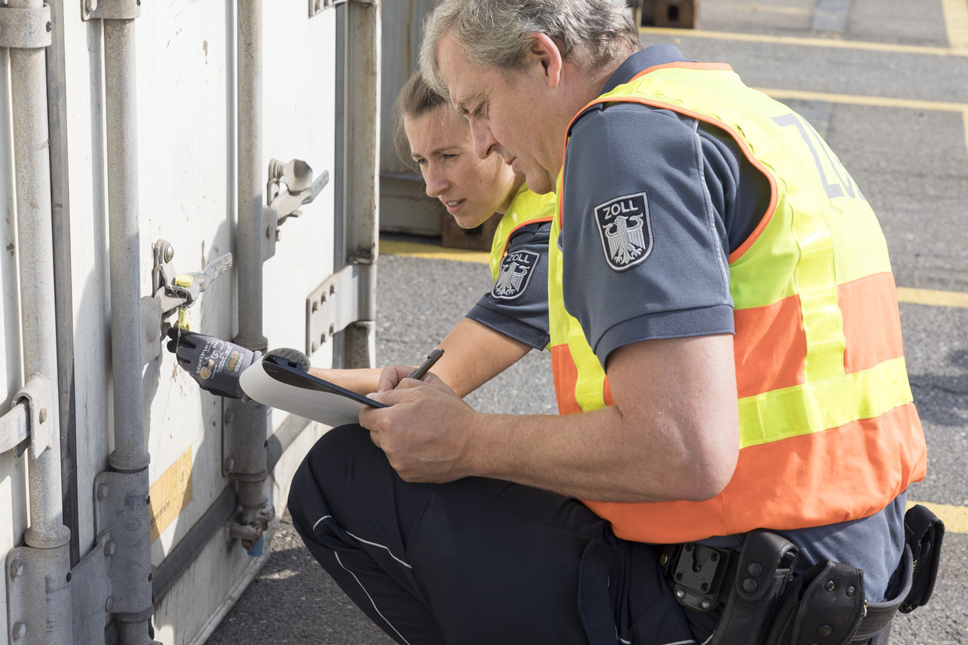
The authorities are part of every export process. Without a release from customs, no container can be exported to a country outside the EU. And dangerous goods such as the ones in our example must be registered with the harbour police.
Since the late 1990s, both public authorities have been connected with all parties concerned with exports via the DAKOSY Port Community System. They are notified about the electronic customs and dangerous goods long before the containers reach the Port of Hamburg. Should customs or the harbour police want to examine the contents of the steel box, this can be planned in advance and integrated into the transport process without endangering the container’s punctual loading onto the ship.
The Port of Hamburg is a pioneer in digitalisation. The port’s main customs office has controlled all export figures electronically since 1997. 2006, German customs introduced the ATLAS AES procedure, the operation of which has also been compulsory since 1 July 2009. The digital process will guarantee fast, lean export procedures in the largest German seaport.
The harbour police has also monitored all movements of dangerous goods in the port electronically since the late 1990s using the GEGIS dangerous goods information system. The system, which was developed by DAKOSY, always provides the harbour police with the current overview so they can react very quickly in the event of damage. Informational guidelines, substance databases and damage containment aids are also integrated in the system. This enables the rapid assessment of dangers, planning for first aid and mitigation of the consequences of accidents.
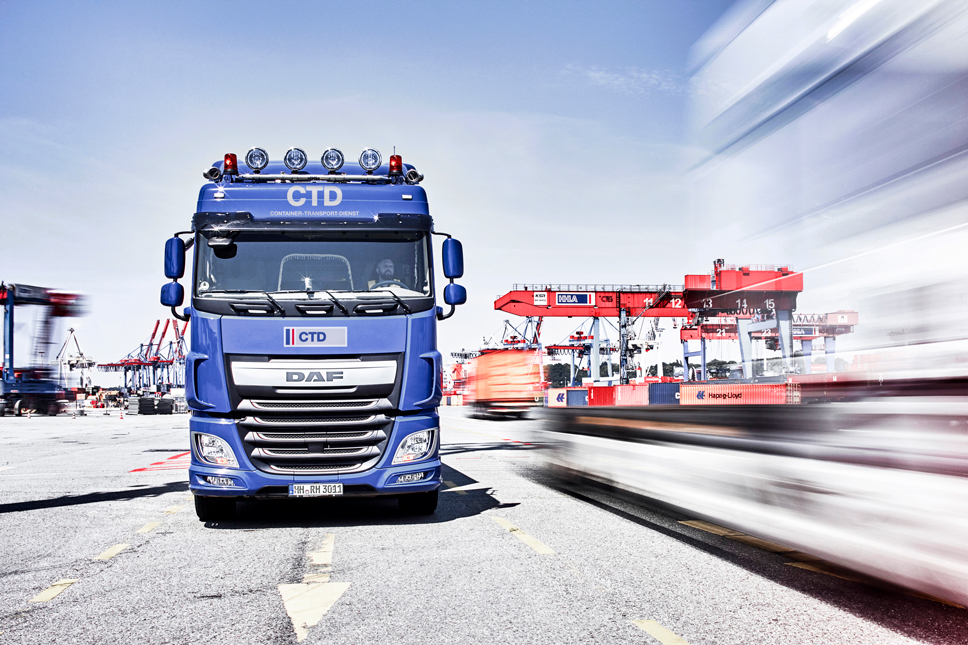
While one of our containers has reached the port punctually by rail, the arrival of the second one by truck is delayed. It’s dispatcher must reserve a delivery time in the port with HHLA via the slot-booking process (SBV). This just requires a couple of clicks on a mobile phone, but it helps all the truckers and the container terminals.
Why? Because the container ships that dock in the Port of Hamburg have continually increased in size. Larger ships mean more trucks need to pick up or deliver their containers from HHLA within the short time periods around the ships’ arrivals. If they all came at the same time, there would be a giant traffic jam. For this reason, the SBV for truckers was introduced in 2017.
All container transports in the port, not only for the HHLA terminals, must be announced and are assigned slots. Such processes, which the rail and aviation industries have long utilised, make the volume of traffic easier to plan for all involved. The SBV has straightened out the traffic situation in the Port of Hamburg, shortened wait times for truckers, and helped the terminals better balance peak loads.
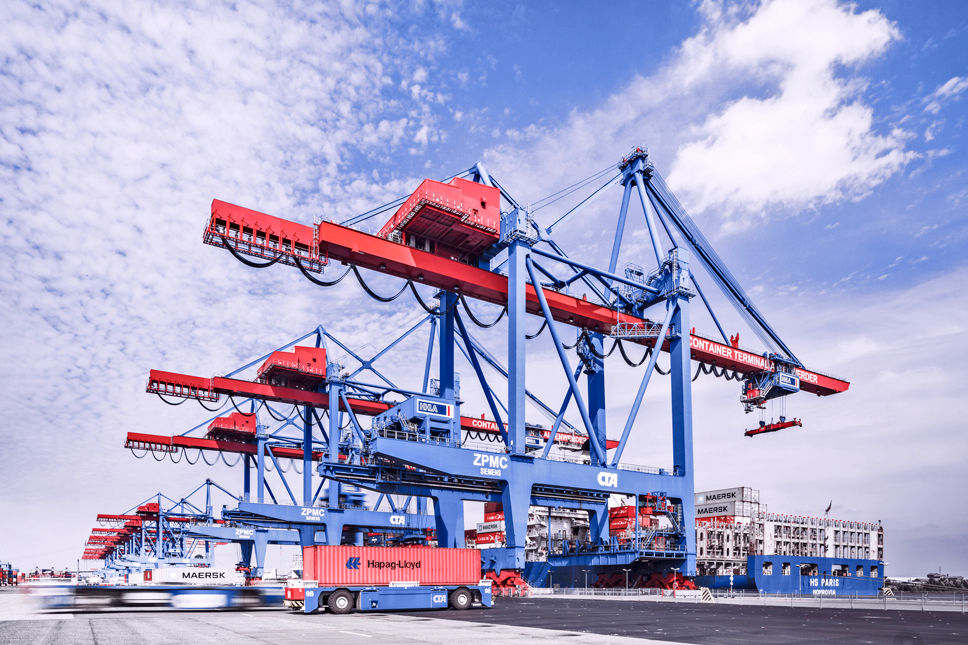
Our rail container reaches HHLA Container Terminal Altenwerder first and the truck arrives a few hours later. Both are recorded by optical character recognition (OCR) gates at the entrance, and their master data is transferred into the IT system. When the data have been recognised as correct and no damage has been detected, the container can be stored directly.
The steel boxes are almost completely IT-driven as they pass through the other stations in Hamburg’s port facilities. A terminal operating system (TOS) developed by HHLA coordinates ten different subsystems centrally. In addition to booking slots, as described above, and providing additional systems for status communication with customers and authorities, the TOS primarily ensures the smooth implementation of container logistics. The software system coordinates procedures in the terminal and assigns a transport process to each container.
In our case, the containers are stored temporarily in block storage until the right time has come for loading onto the MADRID EXPRESS. The TOS coordinates transport so that all processes interlock smoothly. It sends the automated container transporter (AGV) to the storage crane, which is also automated. Here the container is picked up and driven to the correct container gantry crane.
As if by magic: this is how the CTA works
The final movement, from the container gantry crane to the ship, is performed by a crane operator. People ultimately control all the process planning – with the support of software. They set priorities, enter orders into the system and place staff where needed. Employees in the control centre follow the entire process 24/7 and don’t only take action when there are technical or organisational interruptions. They monitor and optimise all procedures, or make sure that new requirements can be implemented.
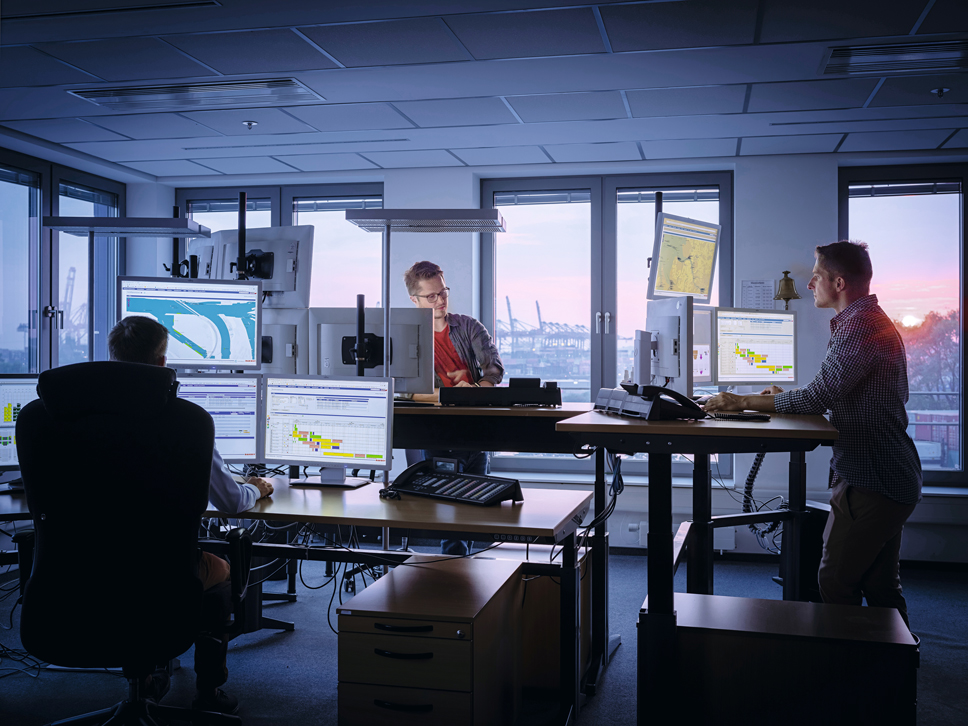
The two export containers have made their data-driven way through the CTA terminal to their ship. In order for the Madrid Express to leave the Port of Hamburg punctually and safely via the river Elbe, the giant container ship requires support.
Learn more about the MADRID EXPRESS
The Hamburg Vessel Coordination Center (HVCC) handles centralised, cross-operational coordination activities. This is important: with more than 8,000 ships making port calls per year, there are many requirements and conditions placed on the river Elbe and the port. The system allows potential route conflicts to be recognised and solved in advance, all in close cooperation with the port authorities.
HVCC has already had the ship “on its radar” since it arrived in Europe, and the Nautical Terminal Coordination (NTC) section has issued a passage plan with all information that is relevant to its arrival in the Port of Hamburg. Now that the containers have been loaded onto the ship, the departure plan has long been completed.
Until it departs, tide windows, weather reports and oncoming ships will be monitored around the clock. If changes result from the real-time data, they will be immediately shared, and appropriate measures will be initiated. In 2019, the NTC coordinated approximately 3,200 mega-ship calls and 3,800 plans of passage using this method.
The Port of Hamburg is one of the world’s largest container ports. This development would never have been possible without digital networking.


In the early 1980s, when the handling volume was still less than a million TEU, transport-related information was transmitted via courier, fax or the post. Only in the best case did the cargo and accompanying information reach the terminals at the same time. If information was delayed, the containers had to wait for it. For this reason, the port management initiated a new kind of communication system, and when DAKOSY was founded in 1982, the port entered the world of digitalisation.
The Port Community System, customs software, import and export platforms, slot-booking process, and the software for optimised ship arrivals and departures were all developed by DAKOSY. This allowed port management to make practical use of the new technical possibilities and to use the existing information. “Intelligent processes are the backbone of the port, the prerequisite for fast and efficient handling processes, and thus the digital gateway to the world of transport,” says Ulrich Wrage, CEO of DAKOSY AG, stressing the importance of networking for the port.
Jens Hansen, Chairman of the DAKOSY Supervisory Board and CEO of HHLA Hamburger Hafen und Logistik AG, also sees further potential here: “Hamburg is already one of the most digitalised ports in the world today. With the new EMP 4.0 platform, it will extend its reach deep into the hinterland. The platform provides all those involved – including HHLA – with maximum transparency, and thus improved control of all flows of goods to and from the Port of Hamburg. Innovative projects such as these are the reason that Hamburg will retain its leading position among the ports.”